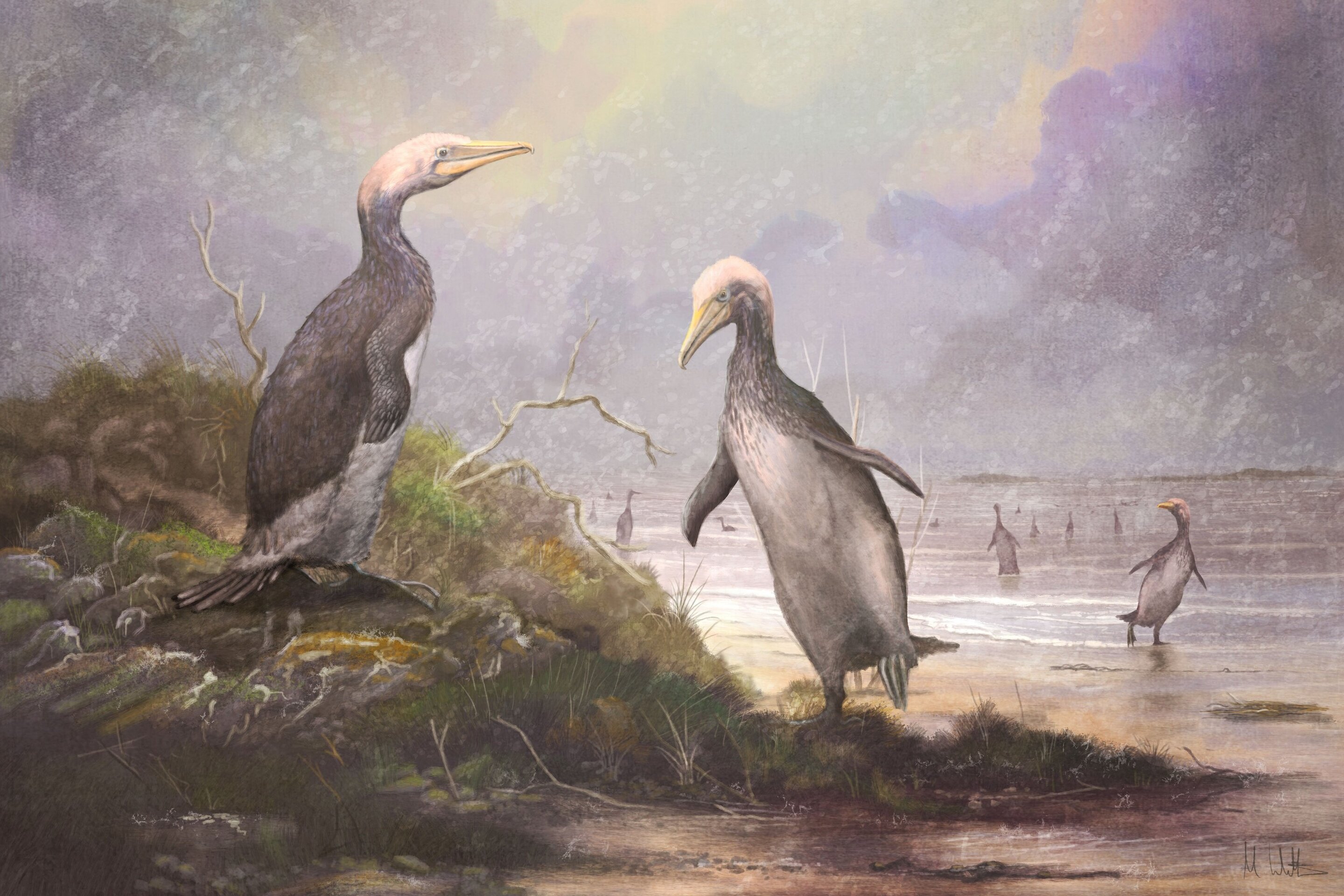

Plotopterids like these Copepteryx looked remarkably like penguins. Credit: Mark Witton. Available for current and media use; all other rights reserved
The monster penguins of New Zealand, which lived 62 million years ago, had doppelgangers in Japan, the United States, and Canada, according to a study published today in the Journal of Zoological Systematics and Evolutionary Research has found.
Scientists have identified striking similarities between the fossilized bones of penguins and those of a much younger group of birds in the northern hemisphere, the plotopterids.
These similarities suggest that plotopteridae and ancient penguins looked very similar and could help scientists understand how birds began to use their wings to swim instead of fly.
About 62 million years ago, the first known penguins swam in tropical seas that almost submerged the land that is now New Zealand. Paleontologists have found the fossilized bones of these ancient waddlers in Waipara, North Canterbury. They have identified nine species, ranging in size from tiny penguins, the size of today’s yellow-eyed penguin, to monsters that are 1.6 meters tall.
Plotopterids developed in the northern hemisphere much later than penguins, and the first species appeared between 37 and 34 million years ago. Its fossils have been found at various sites in North America and Japan. Like penguins, they used their fin-like wings to swim across the sea. Unlike penguins, which have survived into the modern era, the last species of plotopterid became extinct about 25 million years ago.
Dr. Gerald Mayr of the Senckenberg Research Institute and Museum of Natural History, Frankfurt, James Goedert of the Burke Museum of Natural History and Culture and the University of Washington, USA, and curators of the Canterbury Museum, Dr Paul Scofield and Dr. Vanesa De Pietri compared the fossilized bones of plotopterids with fossil specimens of the giant penguin species Waimanu, Muriwaimanu, and Sequiwaimanu from the Canterbury Museum collection.
They found plotopterids, and the ancient penguins had similar long bills with slit-like nostrils, similar bones in the chest and shoulders, and similar wings. These similarities suggest that both groups of birds were strong swimmers who used their wings to propel them underwater in search of food.

Giant penguins, such as these Kumimanu, who lived in Aotearoa, New Zealand, about 60 million years ago, bore a striking resemblance to some plotopterids. Credit: Mark Witton. Available for current and media use; all other rights reserved
Some species in both groups could grow to enormous sizes. The largest known plotopteridae were over 2 meters long, while some of the giant penguins were up to 1.6 meters tall.
Despite sharing a number of physical characteristics with ancient and modern penguins, plotopteridae are more closely related to boobies, gannets, and cormorants than to penguins.
“The surprising thing about all of this is that plotopterids and ancient penguins developed these shared characteristics independently,” says Dr. De Pietri. “This is an example of what we call convergent evolution, when related distant organisms develop similar morphological features under similar environmental conditions.”
Dr. Scofield says that some large species of plotopteridae would have seemed very similar to ancient penguins. “These birds evolved in different hemispheres, millions of years apart, but from a distance it would be difficult to tell them apart,” he says. “The polypeptides looked like penguins, they swam like penguins, they probably ate like penguins, but they weren’t penguins.”
Dr. Mayr says that the parallels in the evolution of bird groups suggest an explanation for why birds developed the ability to swim with their wings.
“Wing-powered diving is quite rare among birds; most swimming birds use their feet. We believe that both penguins and phototodopters had flying ancestors that dove from the air in search of food. With Over time, these ancestral species improved in swimming, and worse when flying. ”
The New Zealand giant penguin fossils, including Waimanu and Sequiwaimanu, are currently on display alongside life-size bird models at the Canterbury Museum exhibit, “Old New Zealand: Squawkzilla and the Giants,” extended through August 16. 2020.
The comparative osteology of the Penguin-like Middle Cenozoic Plotopteridae and the first true fossil penguins, with commentary on the origins of wing-powered diving, by Gerald Mayr, James L Goedert, Vanesa De Pietri, and R Paul Scofield is published in the Journal of Zoological Systematics and Evolutionary Research.
Scientists say monster penguin once swam New Zealand’s oceans
Journal of Zoological Systematics and Evolutionary Research, DOI: 10.1111 / jzs.12400
Provided by the Canterbury Museum
Citation: Ancient New Zealand monster penguins had northern hemisphere doppelgangers (2020, June 30) retrieved on July 1, 2020 from https://phys.org/news/2020-06-zealand-ancient-monster-penguins- northern.html
This document is subject to copyright. Other than fair dealing for private research or study purposes, no part may be reproduced without written permission. The content is provided for informational purposes only.